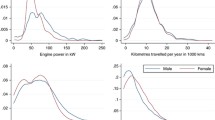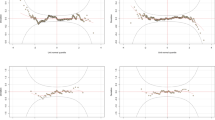Abstract
In this paper, we explore the effects of gender and other demographic features and benefit provisions on insurance premiums using individual data from a property and liability insurer domiciled in Georgia for three types of automobile insurance coverages: collision insurance, comprehensive insurance, and liability insurance. We report the implicit prices of individual and automobile underwriting attributes and find that the effect of gender on the insurance premium for each of our coverage types is significant but has a lower absolute effect than other underwriting attributes, raising questions about the regulatory impact of unisex statutes. Finally, we examine three alternatives open to the regulator who must mandate and monitor insurance pricing under a unisex statute.
Similar content being viewed by others
References
Bond, Eric W., and Keith J. Crocker. 1991. “Smoking, Skydiving, and Knitting: The Endogenous Categorization of Risks in Insurance Markets with Asymmetric Information”.Journal of Political Economy 99: 177–200.
Boyer, Marcel, and Georges Dionne. 1989. “An Empirical Analysis of Moral Hazard and Experience Rating”.Review of Economics and Statistics 71: 128–134.
Chang, L., and W. Fairley. 1979. “Pricing Automobile Insurance under Multivariate Classification of Risks: Additive versus Multiplicative”.Journal of Risk and Insurance 46: 73–96.
Crocker, Keith J., and Arthur Snow. 1985. “A Simple Tax Structure for Competitive Equilibrium and Redistribution in Insurance Markets with Asymmetric Information”.Southern Economic Journal 51: 1142–1150.
Crocker, Keith J., and Arthur Snow. 1986. “The Efficiency Effects of Categorical Discrimination in the Insurance Industry.Journal of Political Economy 94: 321–344.
Courts, S. 1984. “Motor Premium Rating”.Insurance: Mathematics and Economics 3: 73–96.
Dionne, Georges, and Charles Vanasse. 1991. “Automobile Insurance Rate-Making in the Presence of Asymmetrical Information.” Working Paper, Center for Research on Transportation and Economics, University of Montreal.
Fairley, W., T. Tomberlin, and H. Weisberg. 1981. “Pricing Automobile Insurance under a Cross-Classification of Risks: Evidence from New Jersey”.Journal of Risk and Insurance 48: 505–514.
Jee, Beomha. 1989. “A Comparative Analysis of Alternative Pure Premium Models in the Automobile Risk Classification System”.Journal of Risk and Insurance 56: 434–459.
Harrington, Scott E. 1986. “Estimation and Testing for Functional Form in Pure Premium Regression Models”.ASTIN Bulletin 16: S31-S43.
Insurance Information Institute. 1989.Auto Insurance Issues.
Lucas, Robert E.B. 1977. “Hedonic Wage Equations and Psychic Wages in the Returns to Schooling”.American Economic Review 67: 549–558.
Puelz, Robert, and Arthur Snow. 1991. “Evidence on Adverse Selection: Equilibrium Signalling and Cross-Subsidization in the Collision Insurance Market.” Working Paper #91-315E, Department of Economics, University of Georgia.
Riley, John G. 1979. “Informational Equilibrium”.Econometric 47: 331–359.
Riley, John G. 1983. “Adverse Selection and Statistical Discrimination: Further Remarks”.Journal of Public Economics 20: 303–307.
Rosen, Sherwin. 1974. “Hedonic Prices and Implicit Markets: Product Differentiation in Pure Competition”.Journal of Political Economy 82: 34–55.
Sant, D. 1980. “Estimating Expected Losses in Auto Insurance”.Jouranl of Risk and Insurance 47: 133–151.
U.S. General Accounting Office. 1987.Auto Insurance: State Regulation Affects Costs and Availability.
Weisberg, H., T. Tomberlin, and S. Chatterjee. 1984. “Predicting Insurance Losses under Cross-Classification: A Comparison of Alternative Approaches”.Journal of Business and Economic Statistics 2:170–187.
Author information
Authors and Affiliations
Rights and permissions
About this article
Cite this article
Puelz, R., Kemmsies, W. Implications for unisex statutes and risk-pooling: The costs of gender and underwriting attributes in the automobile insurance market. J Regul Econ 5, 289–301 (1993). https://doi.org/10.1007/BF01065955
Issue Date:
DOI: https://doi.org/10.1007/BF01065955




